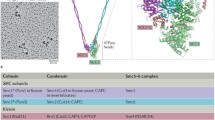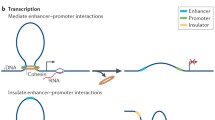Abstract
Chromosome compaction is an essential prerequisite for the faithful segregation of chromosomes during cell division. SMC proteins promote the compaction and resolution of sister DNA molecules. They form ring-like structures that are thought to tie selected segments of chromosomes together. The underlying molecular mechanisms, however, are still poorly understood. Insights gained for the bacterial ancestor of SMC provide an excellent basis for our general understanding of these highly conserved molecular machines.
Similar content being viewed by others
Literatur
Nolivos S, Sherratt D (2013) The bacterial chromosome: architecture and action of bacterial SMC and SMC-like complexes. FEMS Microbiol Rev 38:380–392
Wilhelm L, Bürmann F, Minnen A et al. (2015) SMC condensin entraps chromosomal DNA by an ATP hydrolysis dependent loading mechanism in Bacillus subtilis. Elife 4:1–18
Le TBK, Imakaev MV, Mirny LA et al. (2013) High-resolution mapping of the spatial organization of a bacterial chromosome. Science 342:731–734
Wang X, Le TBK, Lajoie BR et al. (2015) Condensin promotes the juxtaposition of DNA flanking its loading site in Bacillus subtilis. Genes Dev 29:1661–1675
Gruber S, Errington J (2009) Recruitment of condensin to replication origin regions by ParB/SpoOJ promotes chromosome segregation in B. subtilis. Cell 137:685–696
Sullivan NL, Marquis KA, Rudner DZ (2009) Recruitment of SMC by ParB-parS organizes the origin region and promotes efficient chromosome segregation. Cell 137:697–707
Minnen A, Bürmann F, Wilhelm L et al. (2016) Control of Smc coiled coil architecture by the ATPase heads facilitates targeting to chromosomal ParB/parS and release onto flanking DNA. Cell Rep 14:2003–2016
Hu B, Itoh T, Mishra A et al. (2011) ATP hydrolysis is required for relocating cohesin from sites occupied by its Scc2/4 loading complex. Curr Biol 21:12–24
Soh Y, Bürmann F, Shin H et al. (2015) Molecular basis for SMC rod formation and its dissolution upon DNA binding. Mol Cell 57:1–14
Author information
Authors and Affiliations
Corresponding author
Additional information
Larissa Wilhelm Jahrgang 1989. 2007–2012 Studium der Molekularen Biotechnologie an der FH Campus Wien, Österreich. Seit 2013 Doktorandin in der Arbeitsgruppe von S. Gruber, Max-Planck-Institut für Biochemie, Martinsried.
Stephan Gruber Jahrgang 1978. 1996–2001 Chemiestudium an der Universität Wien, Österreich. 2005 Promotion am Institut für Molekulare Pathologie (IMP), Wien. Bis 2010 Post - doktorand am Zentrum für bakterielle Zellbiologie, Newcastle upon Tyne, UK. Seit 2010 Gruppenleiter am Max-Planck-Institut für Biochemie, Martinsried. Ab August 2016 an der Universität Lausanne, Schweiz.
Rights and permissions
About this article
Cite this article
Wilhelm, L., Gruber, S. Chromosom in Schleifen: SMC-Kom - plexe als molekulare Kabelbinder?. Biospektrum 22, 356–358 (2016). https://doi.org/10.1007/s12268-016-0696-x
Published:
Issue Date:
DOI: https://doi.org/10.1007/s12268-016-0696-x




